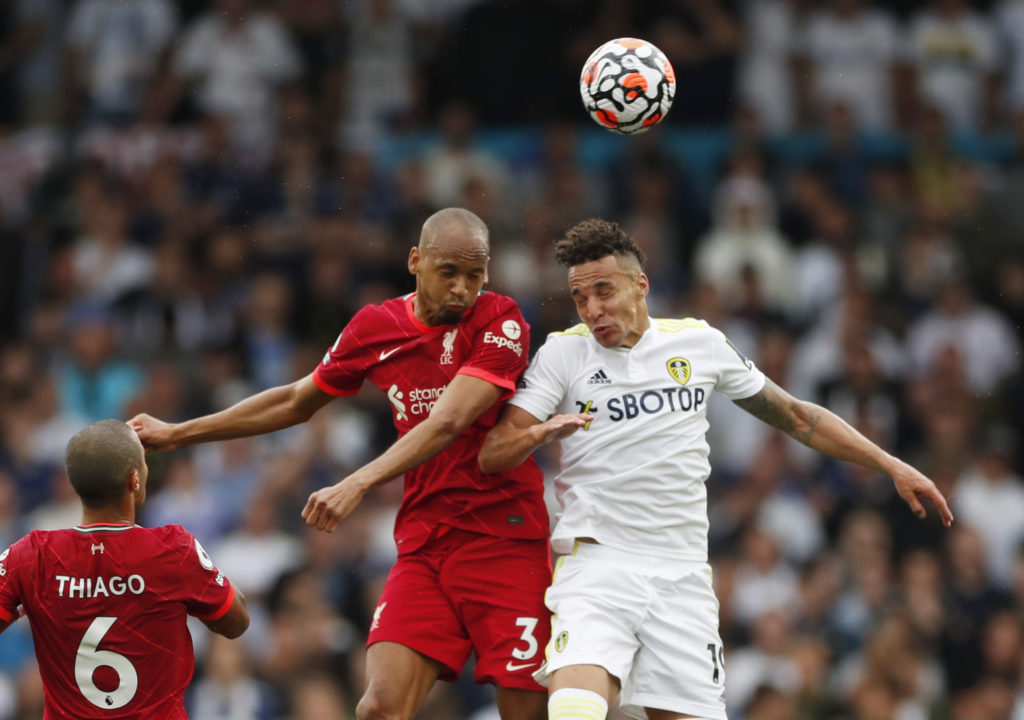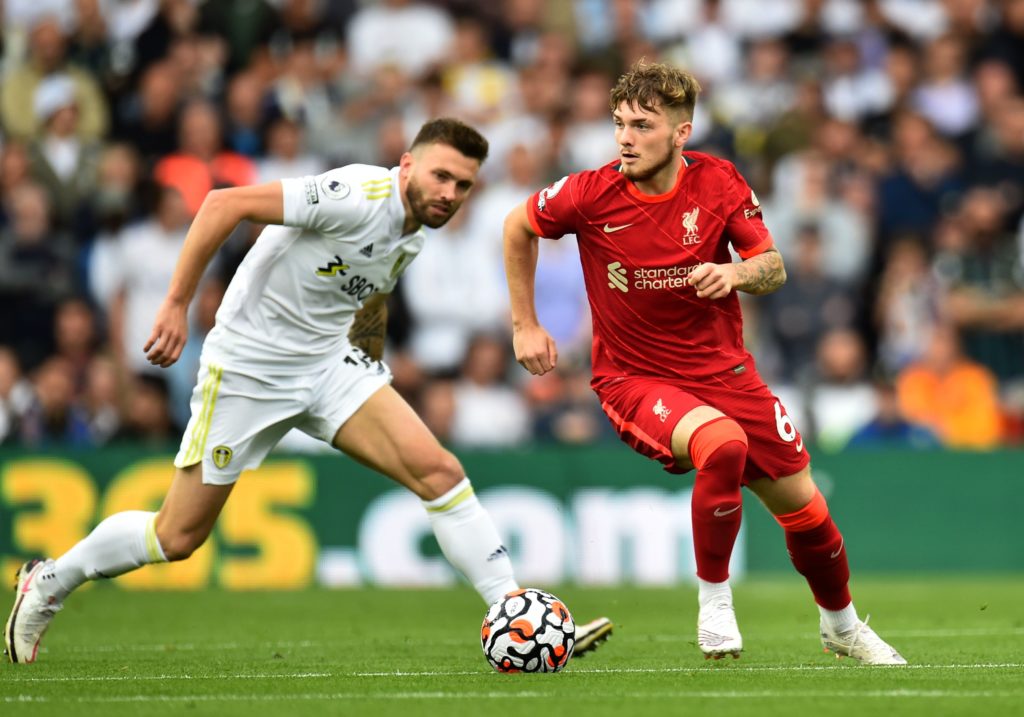
Leeds United have a favourable run of fixtures coming up, starting in Gameweek 5. Last season, this would mean a double or even triple-up on their Fantasy Premier League (FPL) assets. However, the early-season results have left many wondering if this is wise.
In this article, I’ll cast an eye over Leeds United so far in 2021/22, how this compares to the previous campaign and how we could expect the Whites to line up in the coming weeks, all within a Fantasy context.
But first, let’s just get this out of the way: Patrick Bamford (£7.9m) has been confirmed fit by Marcelo Bielsa!
2020/2021 vs 2021/2022
The new season is young, so rather than trying to draw firm conclusions from the data, we should instead look for trends. For example, signs of continuation or deviation from last season’s numbers.
Expected Goals Conceded

In 2020/21 (the first table above), Leeds were ranked fifth-worst for expected goals conceded (xGC) in the league with 58.71 (61.4 minutes per xGC). They managed to overperform this by just over four and a half goals across the season.
However, in the final 12 matches of 2020/21, the overperformance was more pronounced. Leeds conceded 10 goals from an xGC of 17.35 (65.8 mins/xGC). That is an overperformance of 7.35, which is comfortably the highest in the league over that period.
In 2021/22 (second table, above), Leeds have an xGC of 8.94, which is 42.7 mins/xGC. As we can see, all three clubs listed have a poorer mins/xGC than any club did in 2020/21, which suggests this is going to be heavily influenced by luck and the fixtures over the opening few matches. However, we can perhaps identify trends and a hierarchy.
Bielsa’s side have conceded two more goals than expected so far, but with only four matches played and Manchester United scoring five from an xG of only 1.47, we should not read too much into this.
Overall, it looks like the Whites have very much picked up where they left off. The accelerated rate of xGC from the end of the 2020/21 season has continued into 2021/22 and, despite the relatively tough opening fixtures, does not necessarily show any signs of reversing.
Expected Goals

In 2020/21 (first table, above), Leeds were the sixth-best side for expected goals (xG) in the league, with 56.36 (or 64 minutes per expected goal), overperforming this by roughly five and a half goals.
So far in 2021/22 (second table, above), this has dropped to 93.6 mins/xG (4.08 xG), which is the seventh-worst tally in the league. Leeds have performed exactly to the expected numbers, with four goals: Luke Ayling’s (£4.5m) wonder strike against Manchester United being balanced out by some poor misses, such as Rodrigo (£6.5m) spurning a roughly 0.3 xG (qualifying it as a big chance) shot against Liverpool.
This is a small sample and the fixtures have been relatively unkind – three of the four opponents finished last season in the top half for xGC – but the trend is not promising. Unlike the defensive numbers, the attacking numbers have flipped, going from amongst the best in the league in 20/21 to amongst the worst in 21/22. For a firm conclusion we need more data, but combining this with observations of Leeds’ performances could indicate if something has, or needs to, change for the goals to flow. That may of course simply be the fixtures, which Leeds have.
Assessing Leeds’ Performances

The data suggests a continuation of the poor defence but a reversal in attack. Is this reinforced by what we have seen on the pitch? Can we identify reasons for this? Or is it just variance/fixtures?
The main concern for many Leeds fans like myself is the continued use of Rodrigo (£6.3) in the middle. Despite indications from his time at Valencia that he may well suit this role, the reality has been a harsh contrast.
Offensively, Rodrigo offers roughly what would be expected: chance creation and shots. Although even this could be improved, with several of his passes into Patrick Bamford (£7.9m) and others notably over-cooked or under-hit in recent weeks and his shot volume dropping from 3.08 per 90 (1.94 in the box) to 0.55 per 90 (all in the box) from last season to this.
In terms of involvement, Rodrigo has had 21.08 touches per 90 in the opponent’s half, down from 34.2 last season. Leeds’ touches in the opponent’s half have also dropped slightly, from 281.6 to 256.75 per 90, but Rodrigo’s drop-off has been far sharper, showing the proportionally lesser role he has played so far (12% of team touches to 8%).
The main issue however is not the Spaniard’s attacking contributions, which could be excused given opponents, but his neglection of defensive responsibilities. As an advanced ‘8’ in the 4-1-4-1, as opposed to a more traditional ‘10’ in a 4-2-3-1, he is required to form part of a midfield press and, like all players under Bielsa, has a specific marking job to perform.
Typically, Rodrigo is tasked with marking one of the opposition’s midfielders, whilst Bamford is left to cover both centre backs. This imbalance frees one of our own centre-backs from the strict person-to-person marking system, allowing them to pick up runners, and is the essence of why Bielsa switches from four at the back to three at the back depending on the number of opposition strikers, always covering them both whilst leaving a centre-back free.
This means that one opposition centre-half is always available to carry the ball into our midfield, either striding forwards themselves or offloading to a midfielder who can do the same. Leeds need to rotate marking duties during this phase or cut off the centre-back’s options to prevent it from becoming an issue. This is where we have failed, allowing players like Scott McTominay (£5.4m) to look world class once per season.
Whilst this is not all Rodrigo’s fault, teams regularly targeted Alioski last season, he is the main culprit. The Spaniard does not press backwards as keenly as he presses forwards and regularly leaves us overexposed in the midfield. The solution to this last season was for Bielsa to play Stuart Dallas (£5.4m) at CM and have him perform more of a zonal marking role, either picking up the free centre back as they strode forwards in possession or covering the midfielder that was likely to receive the ball from them.

However, Dallas no longer appears to be doing this. In the matches we have seen so far, he is man-marking like the rest of the team. This was especially evident in the first half of the Liverpool match, where Joel Matip (£5.0m) amassed 77 touches, which is second behind only Andrew Robertson (£7.0m) for Liverpool that day, beating even Trent Alexander-Arnold (£7.5m). 22 of these touches were in the opponent’s half, which is double that of Virgil van Dijk (£6.5m). This is despite Bielsa moving to resolve this issue in the second half.
If Dallas is no longer performing this job in midfield, I would argue he should not be playing there at all. He offers much less in possession than a player like Mateusz Klich (£5.5m), with his touch, awareness and passing falling short of what is required. Whilst his performances last season, especially those of a Fantasy-relevant nature, will never be forgotten, he is not a natural central midfielder and the starkness of this becomes painfully apparent when he is on the same pitch as a master operator like Thiago (£5.4m).
Ultimately, Leeds failed to sign the ‘8’ we needed over the summer. With neither Rodrigo nor Dallas entirely suited to the roles they are playing and Klich seemingly third in line, we are left with a midfield of effectively just Kalvin Phillips (£4.9m). There is hope in Adam Forshaw (£4.5m), but he has been injured for over a year and is without consistent top-flight minutes for even longer.
All of this perhaps explains why Leeds have veered away from the more possession-orientated game we were known for at the start of last season, becoming much more transitional in nature. We often now bypass the middle of the pitch entirely, looking to win the ball quickly and immediately turn it over to Raphinha (£6.5m), who has almost all the creative responsibilities in the side, or Bamford via long balls. A simple but impactful example of this is the fact that in the recent match against Liverpool, Leeds had 44% possession. In the same fixture last season, Leeds had 61%.
Leeds have also relaxed the extremely high press into something more middling, albeit with similar intensity. This may be a result of the midfield issues or an (unsuccessful) attempt to improve our defence.
This combined with the fact that we are now a known quantity – last season, despite all the analysis professional teams do, we still seemed to catch many by surprise, something that can still be seen in the first 15 minutes of matches this season before sides adjust to us – results in our threat diminishing.
The hope is that against poorer sides we can dominate, with Rodrigo’s deficiencies less easily exposed and the likes of him, Raphinha, Jack Harrison (£5.9m) and Bamford able to display their Fantasy potential.
It is worth noting that, last season, Rodrigo was considerably more effective against the weaker sides and that overall Leeds have very much tended to lose to sides better than them and win against sides poorer than them, sometimes dramatically.
How Leeds Are Likely to Line Up
Looking ahead, how do we expect Leeds to line up and what will that mean for our Fantasy assets?
4-1-4-1

This is the Leeds shape we are all most familiar with. The personnel selected here are what I believe to be Bielsa’s current favoured team rather than my own preference. Naturally, if you are reading this article in a few weeks’ time, this may well have changed. More often than not, the 4-1-4-1 is how Leeds will line up.
The main thing to highlight here is that Rodrigo plays as an ‘8’ not a ‘10’, as is often reported. Although, with Rodrigo pushing further forwards it can resemble a 4-2-3-1 at times, with a double pivot of Dallas and Phillips. In the past, it reflected more of a 4-3-3, with three central players, one more advanced one more withdrawn, and two wingers.
Raphinha is the main creator, with Ayling asked to build up down the right. It is worth noting that we have struggled more on the left this season, although Firpo has done a solid enough job in both the defensive and build-up phases. We were, for example, unable to take advantage of the space that Alexander-Arnold left exposed behind him this past weekend, something Harrison was able to exploit in prior meetings.
I would personally like to see Klich start, but Bielsa seems determined to make Dallas and Rodrigo work. That is despite him substituting the former Valencia man out in every match he has started this season, twice at half-time.
3-3-1-3

The 3-3-1-3 is rolled out against teams that play two up front, although there are some rare exceptions to that. Very often, Bielsa will use the exact same players as the 4-1-4-1 here to allow a seamless switch between the two shapes mid-match. Klich may displace Rodrigo, as he did against Everton.
In this shape, the RCB is tasked with progressing the ball whilst the RWB will often invert. In addition to the formational flexibility, this is another reason why Ayling tends to play the RCB role. Although, against Burnley, he did line up at RWB with Llorente the progressor at RCB and Dallas at LWB due to an absent Junior Firpo (£4.8m). This was reverted to the norm by Bielsa when Shackleton came on for Llorente at 65 minutes, however.
3-5-2

The 3-5-2 is one of those rare exceptions to the 3-3-1-3. This has been employed against teams that play three or five at the back themselves. Depending on how Newcastle line up, and namely the number of strikers they field (Bruce has indicated Callum Wilson (£7.4m) is unavailable), this could be what we see on Friday night. We could also line up in a 4-4-2 version of the 4-1-4-1, which is something we have seen occasionally in the past under these circumstances. As discussed earlier, the goal is to have two players pressing the three opposition centre backs to maintain the integrity of the marking system across the pitch.
I have not filled in the personnel here as, frankly, it would be a guess. I will however cover what I believe to be the most likely permutations for each position below.
CF – Bamford
SS – Rodrigo, Raphinha, Harrison
CM – Rodrigo, Raphinha, Klich
CM – Dallas, Klich
DM – Phillips, Klich
LWB – Firpo, Harrison
RWB – Dallas, Shackleton
CB – Ayling, Cooper, Cresswell, Firpo, Phillips
GK – Meslier
Diego Llorente and Robin Koch have been confirmed unavailable by Bielsa, while Pascal Struik is suspended. Cresswell could be in line to make his senior debut at centre-back if we go with three at the back.
This is one of the only occasions that Raphinha could play centrally, be it off Bamford or in the second CM slot. However, with how this formation operates, do not expect that to mean he is playing a traditional ‘10’ role. He is still likely to occupy the space on the right, especially if Dallas is the inverted RWB.
Looking at the fixture calendar, and assuming no tactical surprises, I would expect the following formations against our upcoming opponents:
West Ham (home) – 4-1-4-1
Watford (home) – 4-1-4-1
Southampton (away) – 3-3-1-3
Wolves (home) – 4-1-4-1/3-5-2
Norwich (away) – 4-1-4-1



3 years, 1 month agoWorth WC on this lot? (1FT, 0.2ITB):
Sanchez, Steer
Taa, Shaw, Veltman, Ayling, Tsimikas
Salah, Torres, Greenwood, Raphinha, Brownhill
DCL, Antonio, Lukaku
Bamford or Jimenez on WC?